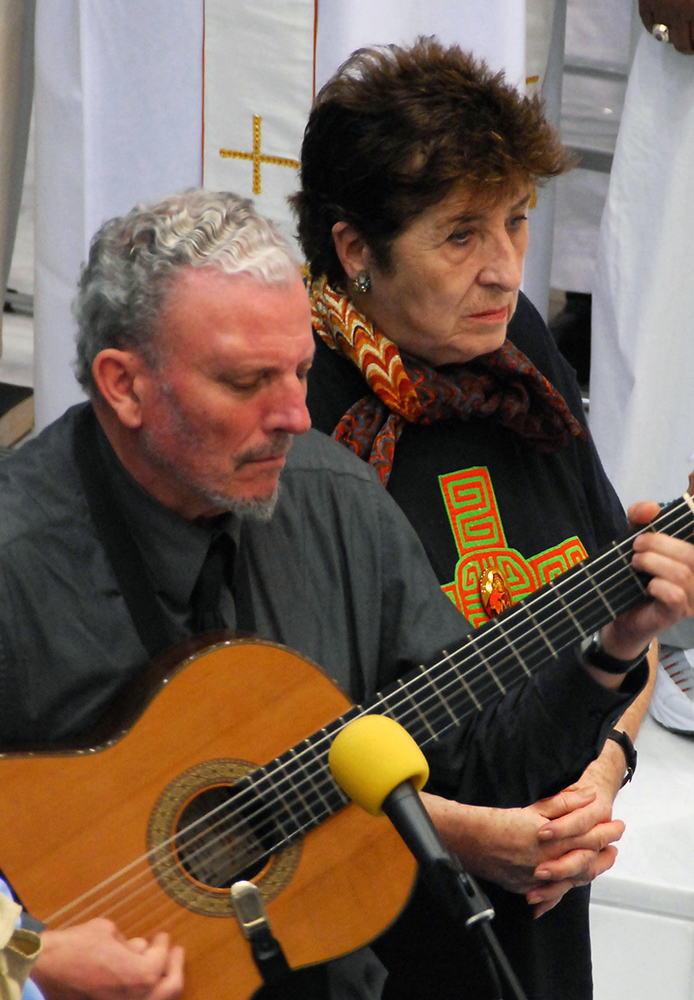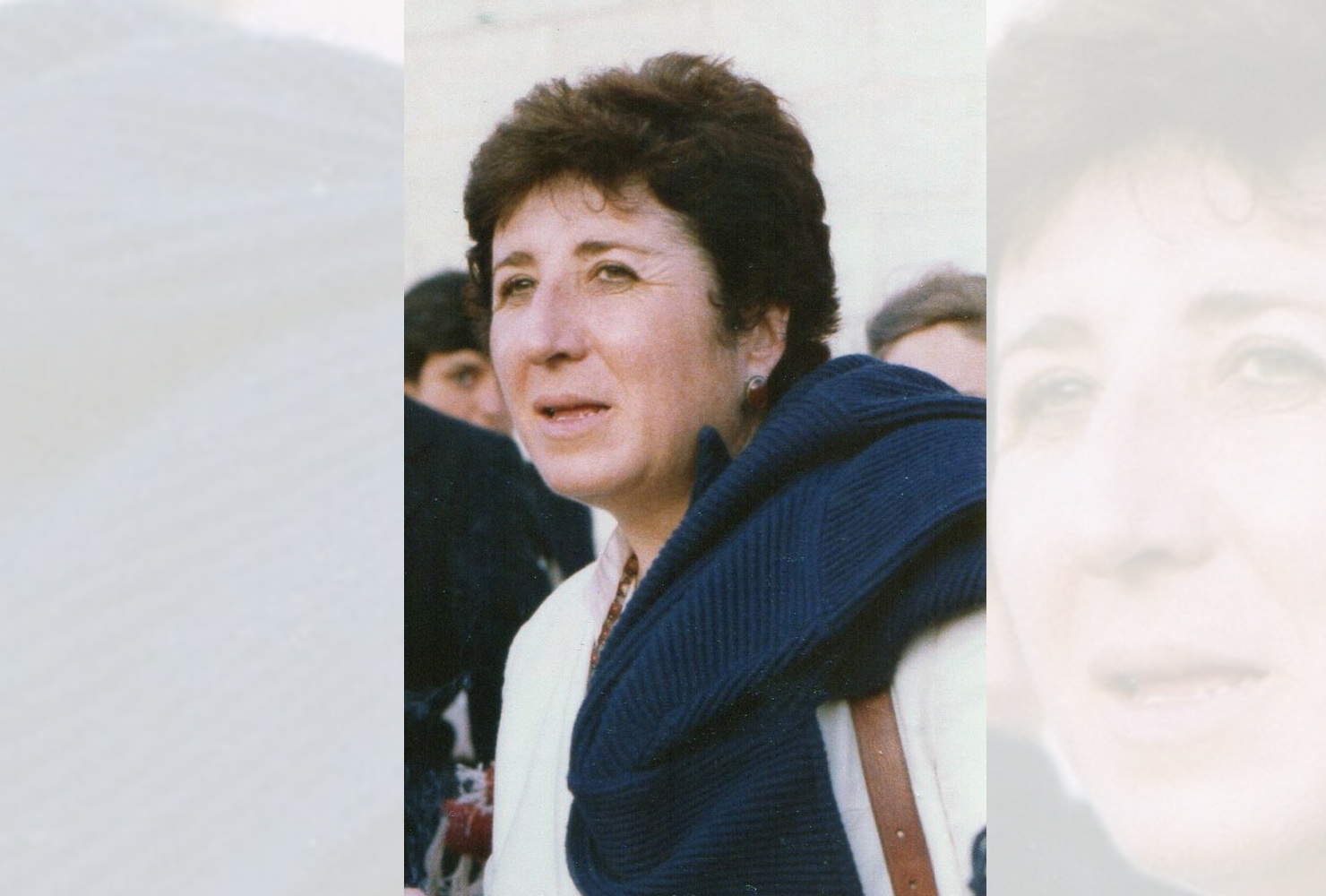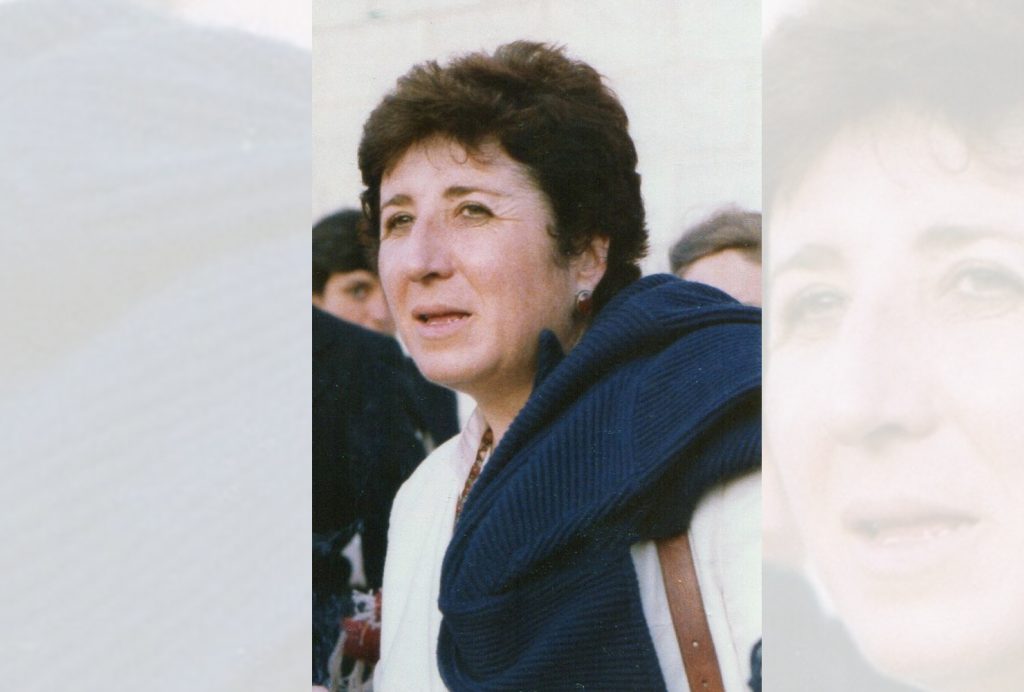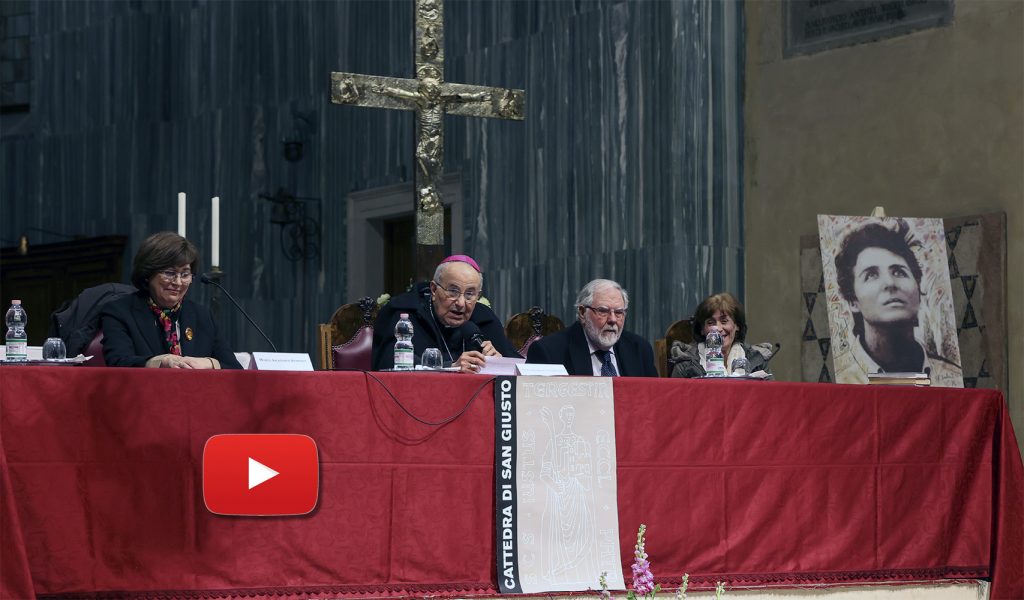After the solemn opening of the diocesan phase of Carmen’s Cause of Canonization on December 4, 2022, we are in a very important phase of studying the documents collected and taking the statements of numerous witnesses.
On July 19, 2023, the seventh anniversary of the death of the Servant of God Carmen Hernandez will be celebrated.
Kiko, Fr. Mario and Ascensión ask that, if possible, the Eucharist be celebrated in each parish on Wednesday, July 19, with the communities, asking the Lord for the eternal repose of her soul and for her canonization process to continue as quickly as possible.
SPEECH ON CARMEN HERNÁNDEZ BARRERA BY Mª ASCENSIÓN ROMERO ANTÓN
“WITNESSES OF GOD”.
CATHEDRAL OF SAN JUSTO TRIESTE (ITALY) March 9, 2023
Carmen never gave lectures. That is why I feel a little strange here. And if I am here, it is because of the experience that when one approaches Carmen, the desire to love Christ as she loved him increases in him. This is what I hope from this meeting: that the Holy Spirit, through a deeper knowledge of Carmen, will instill in all of us present here, a greater love for Christ and the desire to be his witnesses, as the motto of this meeting says: “Witness of God”.
Who is this woman who, on the seventh anniversary of her death, more than 80,000 people have already visited her tomb? Who is this woman who, six years after her death, is already a servant of God? Many aspects of Carmen’s life can be captured. I would like to focus mainly on Carmen the missionary and Carmen the prophet.
Carmen Hernández, initiator together with Kiko Argüello of the Neocatechumenal Way, is a great figure of the 20th and 21st century. It is not by chance that the Cause of her beatification and canonization has been opened on the 60th anniversary of the inauguration of the Second Vatican Council, for the realization of which in the parishes she and Kiko Argüello gave their lives, traveling through the five continents. This is because Carmen was fundamentally a missionary. This is how she identified herself when she told her story. She was a missionary in love with Christ. At the vocation meetings – at the end of the WYD – thousands of young people acclaimed her and asked her for a word, because the truth and the originality with which she preached won over everyone, especially the young women. Yet, even in the midst of her success, she wrote in her diary: “This is of no use to me. The only important thing is the time I spend in intimacy with Jesus Christ.” This was also Carmen: a mystic of our times.
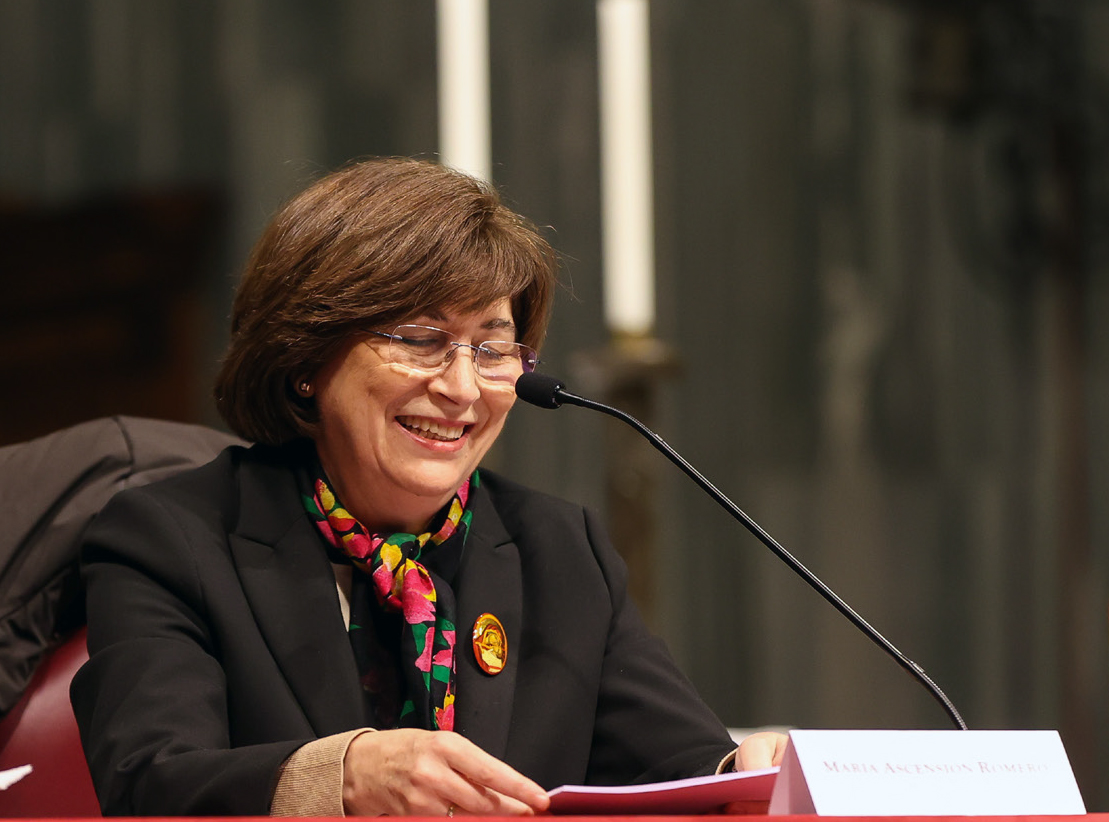
The choice that God made for Carmen from her childhood is impressive and how love for Christ and the missionary vocation developed in her at the same time. Carmen lived in a missionary environment. She lived her childhood in Tudela, in the region of Navarra, in the north of Spain. The Navarra in which Carmen lived was full of missionary spirit under the impulse of the figure of St. Francis Xavier, the patron saint of the missions along with St. Therese of Lisieux. During the 20th century, it was the diocese with the most missionary vocations. It is also interesting to note that the year in which her cause for beatification was opened, in 2022, was the 400th anniversary of the canonization of St. Francis Xavier.
Marcelino Olaechea, who was Bishop of Pamplona when Carmen lived in Tudela, contributed greatly to this missionary environment. Not only did he support the foundation of the Missionaries of Christ Jesus, which Carmen later joined, but he also based all his pastoral work on the figure of the most universal Navarrese: St. Francis Xavier. Taking advantage of the fact that at the beginning of the 20th century he was declared patron of the Catholic missions, the bishop promoted a missionary atmosphere throughout Navarra society. Carmen considered Bishop Marcelino a saint, and maintained a close relationship with him during his years with the Missionaries of Christ Jesus, especially when he was later appointed Archbishop of Valencia.
But in addition to this missionary atmosphere of Navarra, Carmen studied at the College of the Company of Mary, where I also studied as the Bishop said. Opposite this college is the one of the Society of Jesus, of which Carmen spoke to us so many times, and through which she was able to meet many Jesuit missionaries from the East who marked her missionary vocation. I am moved to remember this because the Lord, in Tudela, gave her the first touch of her substance, as St. John of the Cross would say. Like many chosen ones, the Lord marked her from her childhood. She says that when she went to school, she would enter the Cathedral, a jewel of 12th century Romanesque architecture, and there she would pray for an hour every day. Carmen will say: “The gifts I received in the Cathedral of Tudela are unknown to anyone”. She was always excited listening to the Gospel of the miraculous catch of fish, the first Gospel she heard in the chapel of the Holy Spirit in the Cathedral at the age of ten. She said: “It was the first Gospel that I heard in my heart, it was for me a call to evangelization in a surprising way”. I explain all this, not only because I am also from Tudela and these places are very dear to me, but because it was there, in those first years lived in Tudela when the Lord gave her an indelible stamp for Him and for the mission that accompanied her throughout her life. Even in moments of total precariousness and great suffering, these would be the two firm pillars of her life: love for Christ and for the mission.
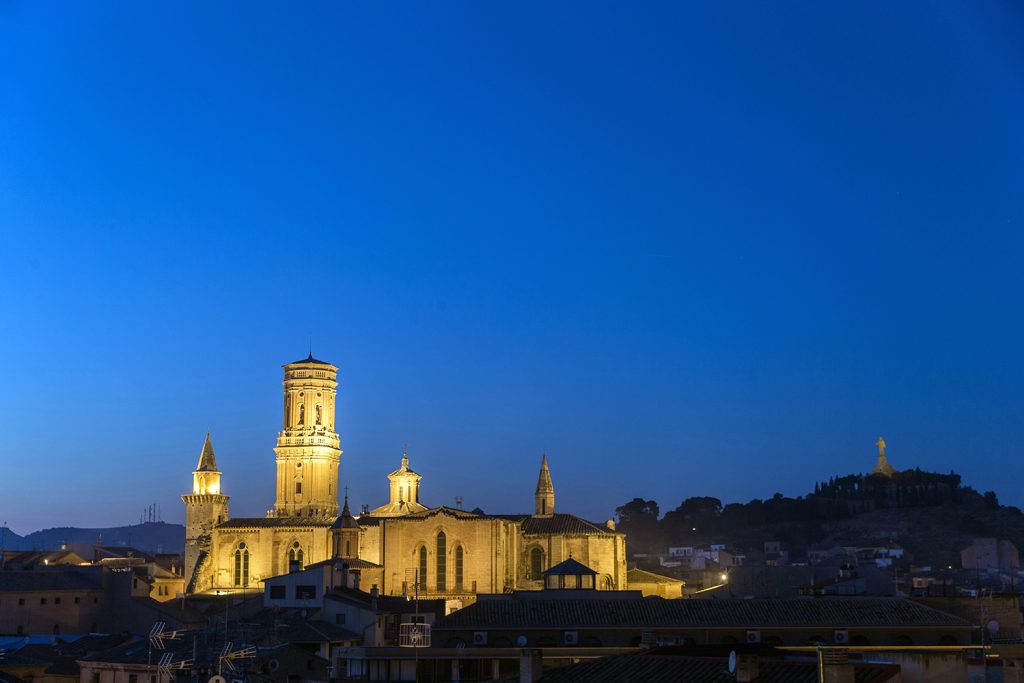
When she was fifteen years old, her family moved to Madrid. She often said that every year she wanted to go on mission, but her father prevented her from doing so. The mystery of the Lord’s choice for Carmen was also confirmed in Madrid, where she found as her spiritual director Father Sánchez, a Jesuit saint – who was also the confessor of St. José María Escrivá de Balaguer, the founder of Opus Dei – who put her in contact with Sacred Scripture and the saints, especially St. Teresa of Jesus. Under the spiritual guidance of Father Sánchez, Carmen led an intense prayer life in her youth. She would pray for an hour in the morning. Then she would attend Mass before going to college and in the evening she would dedicate herself to prayer again. At the suggestion of her father, a great industrialist who had plans for all his children, Carmen studied chemistry at the Complutense University of Madrid, where she obtained very good grades. Also during this university period the Lord continued to give her signs of her choice. Carmen tells us:
“The Lord always gave me many graces, even when I was at university. Jesus Christ pursued me with a visible, tangible presence of immense love and a great call to evangelization. I remember some days, when I went to the Department of Chemistry, when I saw that God was calling me to do a work in the Church: it was always Evangelization and the missions”.
His vocation was so strong that in her adolescence she tried three times to go to the missions, but her family prevented her from doing so. At the age of 21, after graduating in chemistry, she ran away from home and without her father’s permission and with great persecution from her family, she went to Javier, in the region of Navarra, where a modern missionary congregation had recently been founded. She entered the Institute of the Missionary Sisters of Christ Jesus who had their novitiate in Javier. This Institute, in addition to the three vows of all religious congregations – poverty, chastity and obedience – had a fourth vow: to consecrate herself to the missions. This was exciting for Carmen, because it was the answer to her ardent missionary vocation that she had felt since childhood. Her life’s dream was to be a missionary and entering the Institute of the Missionary Sisters of Christ Jesus was the first step in realizing it. Carmen was happy living her two years of novitiate in Xavier. She always felt that God was guiding her life. She says so herself when she writes:
“After many adventures, God led me to the Missionaries of Christ Jesus in Xavier. There the Lord gave me many graces. The Lord was waiting for me in Xavier with great graces of consolation and discovery of the Scriptures. I give many thanks to the Lord because for me it was truly a Cenacle of prayer and of immense graces from the Lord”.
In a letter to her family she wrote: “I am happy learning to be a saint, with all my hope in God and in your prayers.” During the novitiate they made pilgrimages of two or three days to different cities and shrines in the region. Three sisters went without money, announcing Jesus Christ to the people they met and talking about the mission. At night they were welcomed in the villages. It was the first sketch of the announcement of the Gospel two by two that later would be realized in the Neocatechumenal Way.
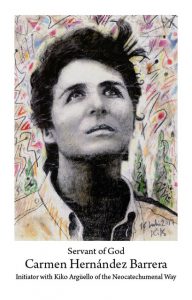
After two years at Javier she took her vows. Before taking them,the novices had a whole month of spiritual exercises. In the third week, dedicated to the Passion, Carmen, who was very focused on the Lord, was impressed by the fact that St. Peter denied Jesus Christ. She said:
“That night I asked to stay in meditation and I spent the whole night thinking that if St. Peter, instead of saying to Jesus Christ: ‘I will not deny you’, had asked him: ‘do not let me deny you’, the Lord would have granted it to him and he would not have denied it.
Carmen was afraid that in the face of suffering she might deny Jesus Christ, that like Peter, she might deny him in moments of darkness and suffering. She said:
“I stayed awake all night with this thought: ‘Lord, let me also follow you in your passion.’
And with this idea she went to sleep. Talking about what she experienced that night, Carmen remembered:
“Among the graces that God granted me there in Javier, there is one that I have never forgotten, not even in the moments of greatest crisis and anguish that I later had in life. It always remained for me as a very strong reminder of God’s intervention in my life”.
See as Carmen recounts what happened to her that night:
“While I was sleeping I had a dream in connection with the Ascension. In that dream I saw Jesus Christ saying to me: “You, follow me”. I see Jesus Christ, I try to follow Him, but I realize that this is madness and He tells me: “You, follow me”. Always in the dream, I am next to Jesus Christ who comes out of the window and I find myself in the void. I start descending, descending, descending, descending, and I am going faster and faster, descending, seeing that I am going to crash and I feel an enormous anguish. Then I hear the voice of Jesus Christ saying to me: “Didn’t you say you wanted to follow me, didn’t you say you wanted to follow me?” I said yes and I entered death. I entered death and at that very moment, circumstances changed. I found myself going up, up, up, up, in a glorious, wonderful, ascension, with a great sense of pleasure and well-being, something that cannot be equated to sexual pleasure, or food, or anything else. It is a beatitude, a being in heaven, next to the Lord, ascending. It was so strong that I said, “Enough, enough, Lord!”. And I woke up having tasted what beatitude is, what heaven is. So much so that it lasted more than a whole month. I felt as if I had been beatified, I lived in heaven, it was something inexplicable.”
This dream will be decisive in her life and she will remember it especially in moments of suffering. She also writes in her diary remembering the feast of the Ascension. We have seen how the splendor of St. Francis Xavier, the most important missionary of modern times, illuminated Carmen’s life from childhood and precisely 450 years after the birth of St. Francis in the Castle of Javier, Carmen made her religious profession in the Basilica of Javier, next to the Castle, where the chapel of the “Smiling Christ” is located, a medieval crucifix before which St. Francis Xavier prayed with his family, the same before which Carmen prayed during her novitiate. The image of this crucifix has always accompanied Carmen.
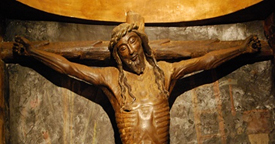
Marcelino Olaechea – who, as I said before, supported the birth of the Institute of the Missionary Sisters where Carmen entered – was appointed bishop of Valencia. There he also prepared a house for the Missionary Sisters. Carmen, after her first vows in Xavier, will continue her formation in Valencia. She lived here for five years, also receiving immense graces. She spent the first two years washing and ironing sheets in the houses – washing machines did not yet exist, she said – and to her great surprise, she was asked to study theology. Those were the years in which the Council was being prepared and that bishop had opened an Institute of Theology with the best professors in Spain, with the novelty of admitting women to the studies, so that the nuns could also study theology. Carmen will study there three years of theological studies, a formation that will be providential for her mission in the Neocatechumenal Way. Her thesis, entitled: “The necessity of prayer in the thought of Pius XII”, will obtain the qualification of “summa cum laude”. It will soon be published also in Italian.
Carmen is about to realize the dream of her life: to go on a mission to India. That is why she is sent to London to learn English so she can enter that country. She will live in London for a year and a half. But during this time many things happen in her Institute. As happened in most of the religious congregations after the Council, her Institute – which was very modern – experienced all this even before the Council. In the tension between conservatism and progressivism, the conservative line wins and the new councilors close those openings with which the Institute was born. Carmen, together with a small group, saw the need to form the missionaries so that in the apostolate they could face the problems of the people at the present time. Thus a disconnection is born between these younger sisters and the new superiors -more linked to the conservative line- and in the end four of them are dismissed; the last one will be Carmen, who is then in England.
A telegram from the Superior General suddenly calls her to Barcelona. When she arrived, she found that three of her companions had been expelled and now it was her turn. This came as a huge surprise to Carmen. They could certainly be expelled, but for serious reasons or sins, and this was not the case. This will be one of the hardest and most difficult moments of her life, because the dream of her whole life disappears: to go on mission, and this happened not for any serious or moral reason, but because the new superiors did not understand the reforms that these young women wanted to propose.
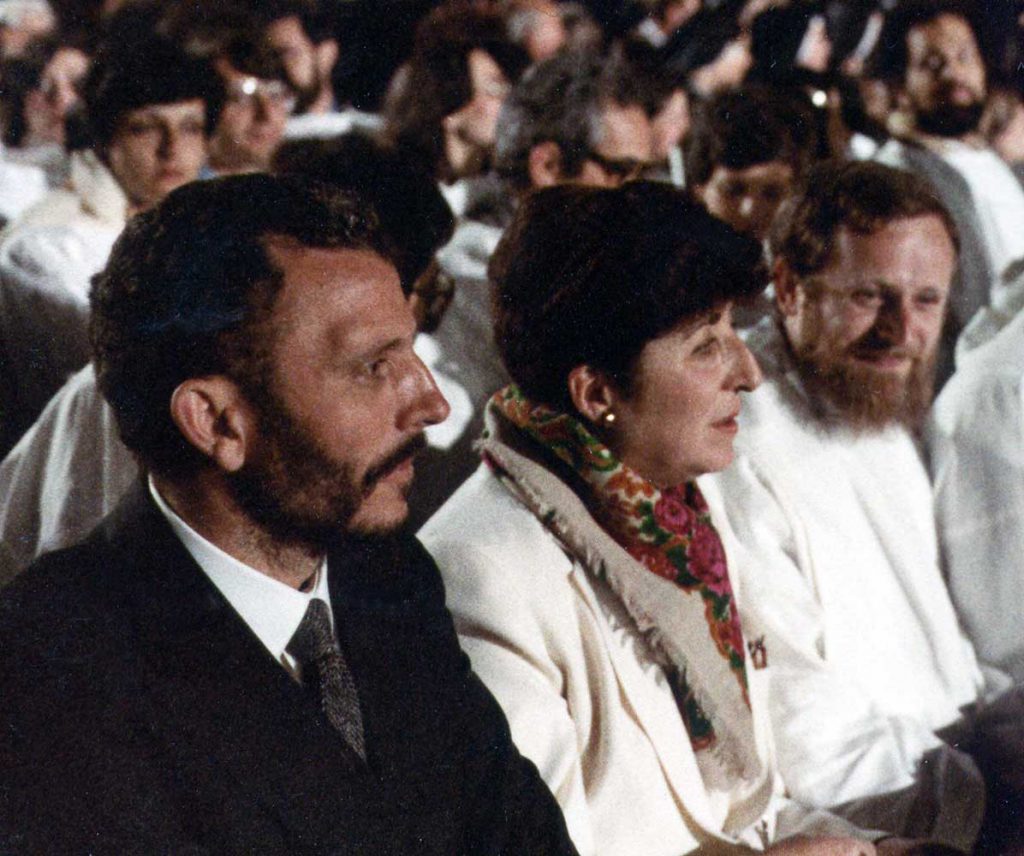
Carmen suffered very much, but this was also a moment of particular grace for the development of her faith and later for the Neocatechumenal Way itself. What Carmen lived in Barcelona will constitute the whole center of the Neocatechumenal Way: Easter, the shining sun of the Resurrection lived in the Eucharist. God will lead her to experience in her own flesh the Easter, the death and resurrection of Jesus Christ. Carmen says:
“The Lord took me to Barcelona to become a true sharer in the passion of Jesus Christ. This kenosis that Barcelona meant to me was truly to enter not into something of the passion, but into the very passion of Jesus Christ: to be judged by one’s own people in the name of the law that He Himself gave, to be cast out of His own people and to be crucified outside the walls.”
In that year that she lived in Barcelona, 1962, God provided Carmen with an encounter that would be fundamental for the Way: Father Pedro Farnés, who appeared at the most critical moment of her kenosis. Farnés was “the angel that God sent her in her Gethsemane”. Farnés, a disciple of Dom Botte and Bouyer, studied and met in Paris the best liturgists who had prepared the reform of the Council.
During the time of his Gethsemane in Barcelona, she comes to wonder if it is normal to have this desire to belong totally to the Lord. She writes in her diary:
“Jesus, I would like to consult spiritual fathers if all people from a young age feel this way that totality of yours, JESUS.”
In the spring of 1962, when she already sensed that she would be expelled from the missionary institute and saw how her life project – that of being a missionary – was falling apart, she wrote to her father:
“All your love and all your attentions are not capable of filling this life that I have always dreamed of being for God alone. Yes, it is a real martyrdom to think only of Jesus Christ, morning, noon and night. I have never had any doubt since I was a child about my vocation. Do you understand my martyrdom?”.
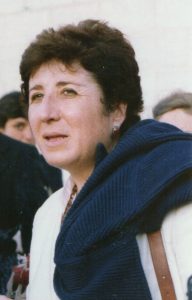
If up to now we have seen Carmen as a passionate missionary, God’s mysterious choice of Carmen appears as a true prophet in Barcelona. He makes her live in her own flesh the work that He wants to manifest in the Way, and in the Church that will be renewed with the Second Vatican Council. God makes her live a series of experiences, as happens to the prophets, so that she understands what God wants to tell her to do. The work of renewal that the Holy Spirit wanted to do in the Church, God does not do it with theories but takes people and does a series of works in them. The same thing God did with the prophet Ezekiel whose wife died, so that he could experience God’s pain for his people, or with the prophet Hosea, whom God asked to marry a prostitute so that he could live in his history the infidelity of his people and announce to them the love of God that is stronger than their sins, He will do the same with Carmen, leading her to experience in her flesh things that are incredible, such as the mystery of Easter, of the death and resurrection of the Lord, which she experienced in Barcelona during the process of expulsion of the Missionaries of Christ Jesus.
Carmen had been very devoted to the Eucharist and since she was a child she never stopped attending mass, as for example when she traveled with her father to Morocco – where it was really difficult to find a Catholic church – and she found a way to go to mass every day. Carmen writes:
“In Barcelona I entered into this paschal dynamism, because the Eucharist is not so much to receive the Child Jesus in the heart, nor Jesus Christ as energy, but to enter into death with Him in order to rise with Him in this song that is the Eucharist. Through all this I came to know all that the Council brought, the ecclesial renewal and the introduction of the Word of God among the people. That is to say, the Lord lead me, who had received all the scholasticism and the formation of the priests, to understand through the experience of kenosis that I was living, all the renewal that the Council gave to the Church. The Council was for me like a nourishment that God gave me, a nourishment that enters into existence itself.”
Through Fr. Farnés Carmen discovered the mystery of Easter: entering into death with Christ in order to rise with Him, which is at the heart of the Second Vatican Council. Carmen recounts:
“In Barcelona, it seemed to me that I was climbing Mount Moria with my vocation, with my son, with the illusion of my whole life to sacrifice it.”
Carmen saw that she had to sacrifice her Isaac, which was her missionary vocation, the project of her existence, the project of her future, to sacrifice her own life and go out into the dark, into the unknown of what God would want from her.
During her stay in Barcelona, she recalled the dream of the “ascension” in the novitiate of Xavier, in connection with the sufferings she was experiencing. She writes in her diary:
“Jesus! I am afraid. I don’t understand or see anything. Jesus! It is terrible; sentence of death and no appeals and no odds. Jesus, are you going to leave me? I am sure of you, I trust in you, I love you. Do you remember that Ascension? Jesus, you are the truth. You are my life; You cannot leave me; I love You, Jesus; and even in the depths of tears, of pain and of the most horrible uncertainty, I feel the joy of Your powerful arm, very strong, stretched out over me, who can separate us? Thank you, Jesus.”
From the beginning of the year Carmen experienced in her flesh the passion of Christ. In the summer of 1962, Carmen was told that she was not to be admitted to vows, and with this decision of her superiors, Carmen mysteriously experienced the resurrection. She writes in her diary:
“July 7, 1962. San Fermín. Jesus, you have already heard it: ‘I AM NOT ADMITTED TO VOWS’. What serenity, Jesus! Sweetest serenity, inexplicable, Yours; it is You, Sweetest, Most Good. PEACE be with you. Jesus Most Sweet, I love You sweetly, madly, totally, what do You want from me? My hand is in Yours, and I go with my eyes closed wherever You want me to go. Thank You Jesus, LOVE JESUS, I love You, I love You, no one can separate us, because my love is Your love, and I am nothing. You are my WAY, my LIFE, Sweetest Jesus, I love You.”
This power of the risen Christ that she experienced in her life was also expressed in a letter to one of her superiors:
“I feel nothing but love and desire to kiss the hands of the one who condemns me. I no longer believe in anything but LOVE. Sweetest serenity, Sweetest Divinity, Sweetest WAY, JESUS, JESUS CHRIST, WAY, TRUTH AND LIFE. I can write that I do not live, but JESUS CHRIST in me, and neither do I lie, nor do I feel vanity in it, I only know that God is LOVE, that JESUS CHRIST is GOD and is LOVE, and that he loves men.”
Carmen’s experience in Barcelona was summed up by Kiko in an interview:
“If Carmen had not gone through that terrible kenosis, to be sentenced in the name of the law, I would not have understood the meaning of the paschal mystery that will bring me and then lead to the Neocatechumenal Way.”
Carmen’s sufferings have been fruitful for Kiko, for the Way, and undoubtedly for the whole Church.
Carmen stayed in Barcelona for a year, along with three other companions who had left the Institute. Her social restlessness led her to live with the poor in the barracks of Barcelona and to work in the factories, always thinking of proclaiming the Gospel to these workers, but they did not know how to do it.
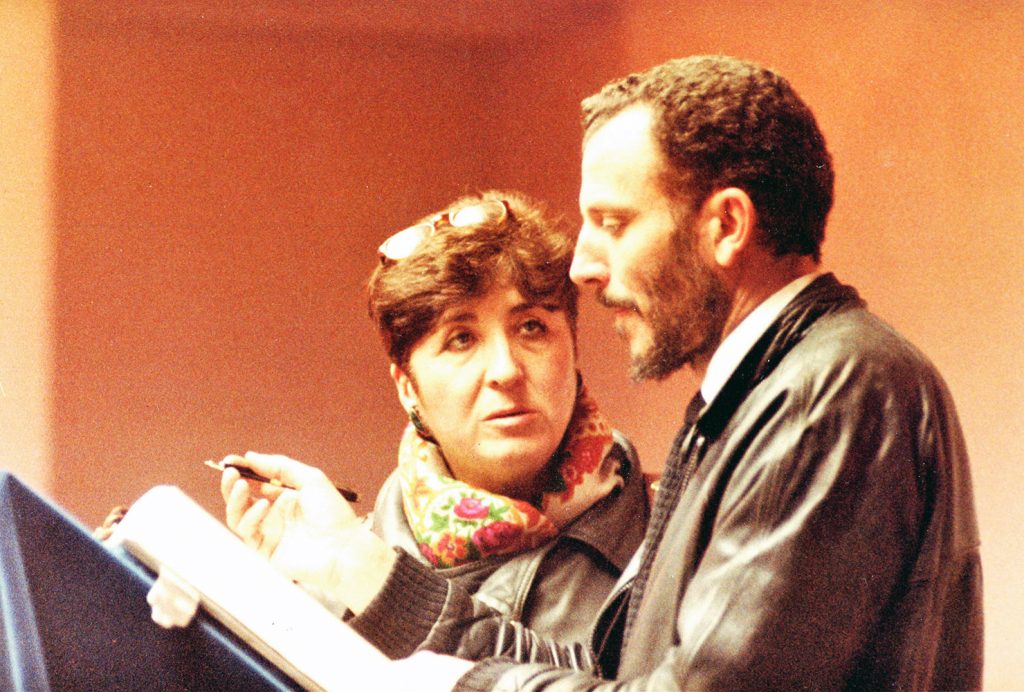
In the meantime, they were preparing to go on mission. Bishop Marcelino Olaechea put her in contact with a bishop in Bolivia, Bishop Manrique, so that they could go on mission among the miners of Oruro. But before leaving, Carmen, following in the footsteps of St. Ignatius of Loyola, went to the Holy Land for a year with the Scriptures. She met an Irish friend who accompanied her, and with a backpack and a tent she traveled all over the Holy Land, where the Lord was waiting for her to give her many graces. She herself recounts that in Israel, on the shores of Lake Tiberias, sitting on the rock of the primacy of Peter, she asked the Lord what he wanted of her and felt that God was telling her that he had manifested his will to her in the Church: love for Christ, present in the work she was to carry out in the Church. In Ein Karem she had the absolute certainty, like a vision, that God wanted something from her for the universal Church, that it was not a matter of founding a congregation, as she thought of doing with her companions, that the Gospel could be incarnated in a woman like her. Then she saw that it was about opening a Christian Initiation together with Kiko Argüello: the Neocatechumenal Way.
The year spent on pilgrimage in Israel was an unforgettable journey for her, in which the Scriptures were opened to her in an impressive way, as she understood the union of the history of salvation with the land in which God wanted to manifest Himself and the importance of knowing the Jewish tradition in order to understand the Gospel. It was a time of marriage with the Lord for her, after the enormous sufferings she had experienced. So much so that 25 years later, Carmen will want to celebrate the silver jubilee of this trip in Israel.
Carmen’s pilgrimage to the Holy Land had a decisive importance for her life and for her mission, so much so that many times she referred to it as “the time of the love of her youth”, as well as for the Neocatechumenal Way. In the book “Todas mis fuentes están en ti” are collected all the beautiful experiences lived by Carmen during this time.
Carmen’s knowledge of the Council and of the land of Israel was the origin of the great love that was born in the Way for Israel, its people and its traditions. Many times, during the preaching, she was moved by the memory of Jerusalem: the Cross of Jesus Christ raised on Golgotha, Jerusalem, the city that is the witness of his Resurrection and Ascension.
The visit of Pope Paul VI to Nazareth in January 1964, during which she was able to be present, helped her to understand the fundamental keys of the Council, seeing in the return to Christian origins and Jewish roots the most important pillars for the renewal of the Church.
It was also in Nazareth that God made her meet Father Gauthier, through whom she learned to collaborate with men. Father Gauthier had founded a kind of congregation in which men and women collaborated, which was a novelty for Carmen. On her return from Israel, Carmen spent some time in Rome, visiting the holy places and thus preparing, without knowing it, the visits that the brothers of the Way would later make. She then returned to Spain.
When she arrived in Barcelona, one of Carmen’s companions had gone to Bolivia and the other two had gone to Madrid, the last place she wanted to go, because her family was already chasing her. But God was closing all the doors until she arrived in Madrid, because He had His plans and in Spain, in Madrid, He made her meet Kiko Argüello in Palomeras Altas. They met in 1964, on his return from his pilgrimage to the Holy Land. Kiko had gone to live in a shack in Palomeras. There Carmen met the community that met in Kiko’s shack and was very impressed by the response that the brothers who gathered there gave to the Word of God. She decided to stay with them in a nearby hut. Kiko recalls the moment of the meeting with Carmen:
“It was in Palomeras where it was possible for Carmen to see Jesus Christ who comes to save sinners and to fulfill the mystery of Easter, to create communion where it is impossible for communion to take place: between normal people and gypsies. Because there we saw and touched the Holy Spirit, who manifested himself creating an incredible communion between gypsies and gypsy people.”
“Carmen came from an experience with her friends in Barcelona, who had worked with workers, giving their lives there, waiting to talk to them about Jesus Christ, after a time of incarnation among them; but that moment never came. However, Carmen saw in my barracks that I spoke of Jesus Christ and that they listened; there she saw how Jesus Christ served: the gratuitous love that God has shown for the salvation of man, to tear him out of slavery, anguish and sin. Jesus Christ made himself present.”
“All that God allowed, all his presence in Palomeras, was like a cultivation ground that God had prepared to start the Neocatechumenal Way. Everything that God made us experience in the midst of a poor world, God had prepared for his Church.”
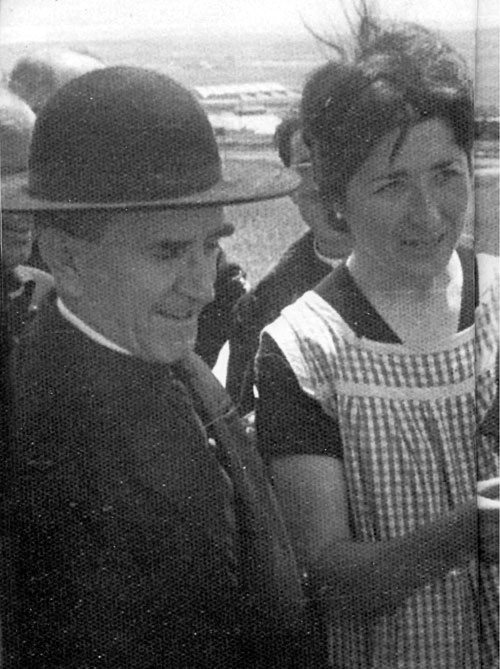
“It was a miracle that Archbishop Morcillo, the Archbishop of Madrid, came to the shanties, an incredible miracle: a counselor of the Kingdom, in Franco’s time, that he showed up there dressed as a priest in a 600; that he entered my shack, that he prayed with us, that he recognized us as his own … THE ARCHBISHOP entered my shack, saw how I lived, how the brothers prayed and said: ‘Kiko, I am not a Christian’. The Civil Guard had begun to demolish the shacks, starting with Carmen’s hut, but the arrival of the Archbishop stopped them.”
“It was the mysterious presence of Bishop Morcillo in the shacks that made Carmen decide to collaborate with me. If it had not been for Morcillo we would not have gone to the parishes. It was he who also opened the doors for us in Italy.”
“Carmen saw in Bishop Morcillo the presence of the Church and completely changed her attitude towards me; through the presence of the Archbishop she saw how the promise God made to her in Israel was fulfilled: that God wanted her to do something for the universal Church, that it was not a matter of founding a congregation. I tell you this so that you may see the collaboration between Carmen and me as a great mystery in the Lord”.
This was recalled by Kiko in the presentation of the biography of “Carmen Hernández – Biographical notes”
Carmen’s vocation was the mission and she never thought of staying in Spain, much less in Madrid, where her family lived. This was for her like a failure of her missionary ideal, but the presence of the Church through the Archbishop of Madrid, Msgr. Casimiro Morcillo, made her decide to stay definitively with Kiko. Thus began a great and unique relationship that will give origin to this charism: “a gift of the Holy Spirit for the Church”, as the Popes have defined the Neocatechumenal Way.
The support of the Archbishop of Madrid, who was always at Kiko and Carmen’s side, was fundamental for them to understand that they could not enter into any socio-political commitment. It was a very difficult time in Spain, in which many religious who lived with the poor, seeking social justice, moved towards communism, and some of them ended up leaving the Church, as happened, for example, with Carmen’s friends.
In reference to the socio-political commitment Kiko recalled:
“Carmen was great, she insisted that in Christianity there is no commitment other than baptism.”
And baptism will be the foundation of the Neocatechumenal Way. God has chosen Kiko and Carmen to initiate the Neocatechumenal Way. He has brought together Kiko’s existential problems, embodied in the kerygma and his vision of making small communities, with Carmen’s theological renewal and her mission of evangelization.
As Fr. Mario said at Carmen’s funeral:
“Historians will delve deeper into this fact: the foundation of an ecclesial reality realized by a man and a woman who constantly collaborated together.”
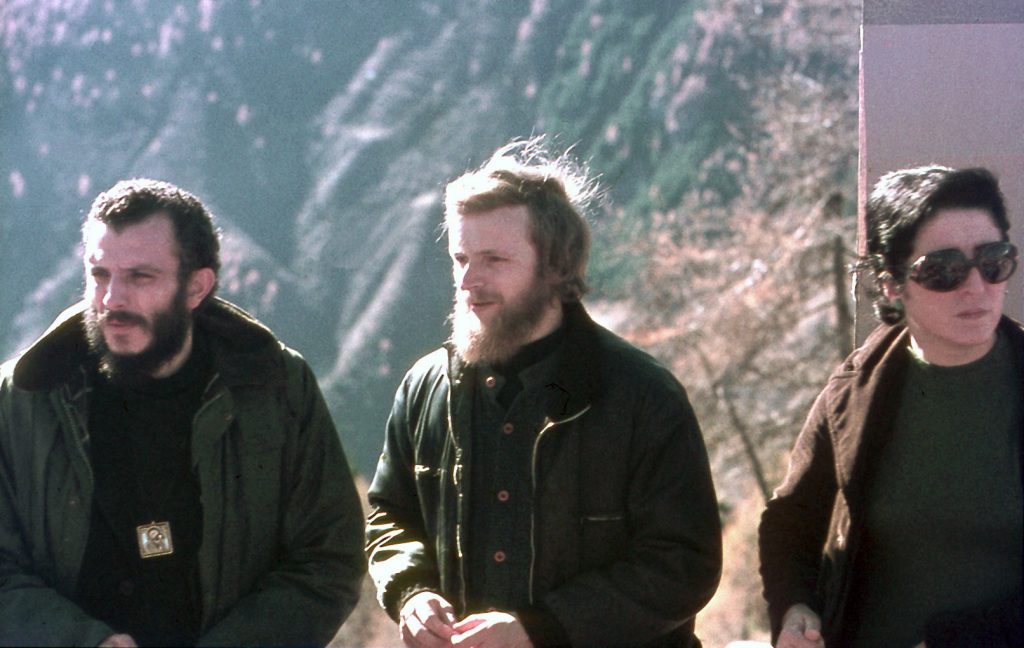
We find such an event for the first time in the history of the Church. It is truly a mystery of God this collaboration for more than 50 years. God made it possible to initiate the Neocatechumenal Way, to renew the Church. A relationship based on faith, a relationship based entirely on the mission to which God called them and which at times was difficult for them. Kiko and Carmen remained faithful without coming down from the cross so that we, the brothers and sisters of the Way, could receive life. Kiko and Carmen’s life together was also an Easter. They died to themselves so that the brothers and sisters might receive the resurrection. In a meeting in 1994, referring to this relationship with Carmen, Kiko said:
“God has brought us together, but always in an uncomfortable way. So that we do not boast, so that it can be seen whether we are truly seeking the will of God or ourselves; we have to accept the discomfort of collaboration for this mission.”
Carmen sometimes writes in her diaries: “Kiko is a mystery”, but so many times talking to Kiko he has told me: “Carmen was a mystery.”
All of us who knew Carmen realized that sometimes she suffered a lot, we could not imagine how much she suffered until we read her diaries. Nothing consoled her. God made her live through periods of great depression, which made her go through the dark night of faith like many great saints. A suffering so strong that sometimes reading her diaries makes the hair on the back of our neck stand on end. She writes in her diaries (March 1985):
“Madrid. Emptiness, nothingness, sadness and impotence. Incommunicability. No desire for anything. My God, what terrifies me most is not believing in You. Have mercy on me. Tell me that YOU ARE. That is enough for me.”
And in 1988 she writes:
“Madrid. My Jesus! What gives me most sadness and suffering is not believing in You. At least I believed in You. LORD, did you deceive me? Your love where is it, and where are You? My Jesus, sad, mute and alone and leprous. I do not see why?”
In 1992 she writes:
“New York. My Jesus, why do YOU disappear? This is the worst disease and my life becomes meaningless, dead.”
In Tokyo:
“Tokyo. My Jesus, without You nothing interests me and everything seems impossible to me. My Jesus, why, I have no faith”.
1994, in Rome, the day they see the Pope to present him the project of the Mount of Beatitudes:
“ROME – VATICAN – POPE – BLESSING of the model for the Mount of the Beatitudes. My Jesus! You are great and wonderful. Do you remember the tent on the Mount of the Beatitudes? And the hurricane? And how much you loved me and I loved you? Return me to You, to your sweet and unique loves”.
He often speaks of the Virgin Mary. I have taken these words from 1996, in Porto San Giorgio:
“Sweetest Virgin MARY, my refuge, blessed YOU who have believed. I see You as a spatial shield in my environment. My Jesus, give me FAITH, for sadness and loneliness and lack of communication make me see everything negative. Most sweet Virgin Mary, protect me with YOUR FAITH.”
He has spent many periods of silence, asking the Lord to be able to preach. Along with words of acceptance of her reality of silence, the words: HUMILITY, HUMILIATION are written next to it. The Lord used her dark nights, which were so many, to make humble and small an exceptional woman, courageous, very intelligent, a missionary full of zeal for the Gospel, scientist, theologian, with a very original and novel preaching, enormously hardworking, tireless researcher, and so many other qualities that we could say about her. The Lord tested her “like gold in the crucible”. A humility that has been demonstrated by remaining with Kiko in the background. Accepting that her mission was to help Kiko.
She has traveled the world proclaiming the Gospel, raising, together with Kiko Argüello, hundreds of vocations to the priesthood, religious and missionary life, as well as entire families, he has worn himself out for the Gospel, announcing the Good News and listening to so many brothers and sisters, their problems and sufferings.
A trait in which has always stood out in Carmen was her courage, her courage and the great freedom she had, because she only cared about doing the will of God; that is why she was free with everyone: she saw the Lord in all events, she was an eschatological woman, as Father Mario likes to say. That is why she helped so many young people, because of the courage she showed by living in the truth and preaching it. She helped many women to value motherhood, the value of being a woman, to have discernment to recognize the traps of the devil who in this generation wants to deceive women because he has the factory of life, – as she said in a wonderful originality -, and this preaching has helped many girls to value being a woman, showing them that there is nothing greater than to beget life, to form a person and to educate a child. She has been a great defender of the Christian family and of women, unafraid to go against the current, unmasking the false feminisms and deceptions behind the promotion of abortion.
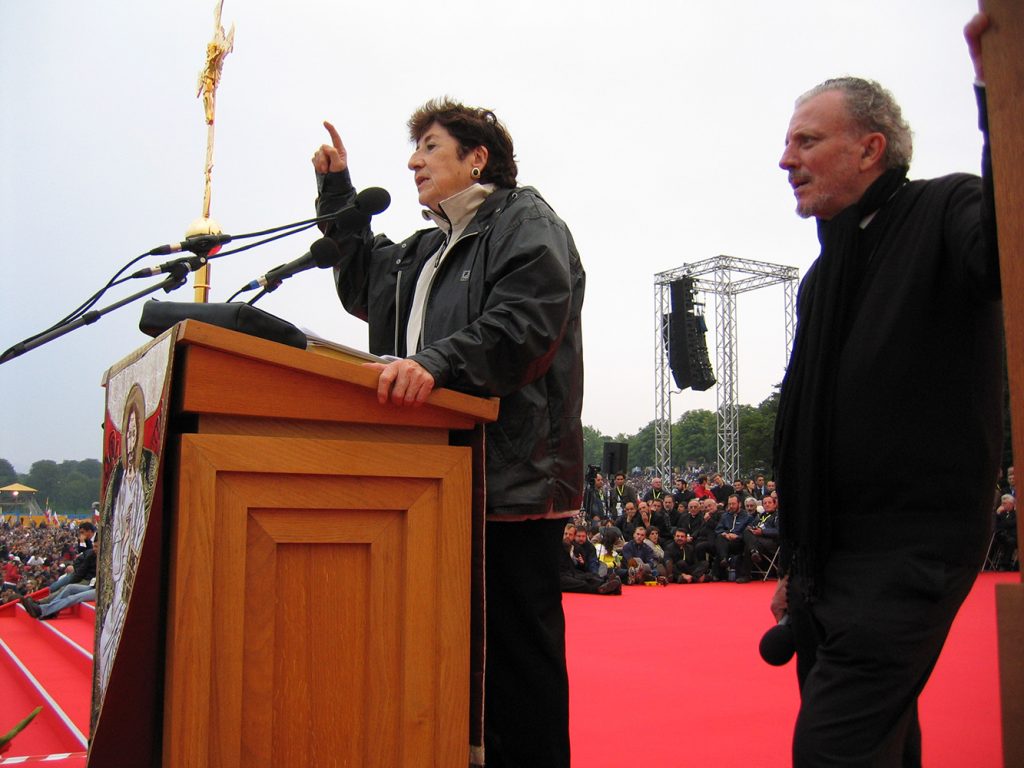
In conclusion, I will tell you that what touches me personally about Carmen is the gratuitousness that she has always shown in her preaching. Conscious of God’s gratuitous election, she sees in all the interventions of the Lord in her life the gratuitousness of his love; this will be the seal of all her preaching. This is clearly seen in her catechesis on the sacraments, especially the sacraments of Penance and the Eucharist. I have selected a few words from the 1992 meeting with the communities in El Salvador, but we could quote any of her catechesis.
“The resurrection of Jesus Christ was not left by God in libraries or universities, but he made a memorial of the Resurrection experience, which is the Eucharist, and that is where the apostles lived it. They all fled from the cross, beginning with St. Peter, who thought he was so honest and loved Jesus Christ so much: ‘I will follow you to death’. When he saw death, he escaped, as we all escape. And it was the Risen Jesus Christ who came to meet them one by one, just as He came to meet each one of us, He, alive, to take us by the hand. This is why Christianity is not attained by anyone, neither with coherence, nor with their good will. The Resurrection of Jesus Christ surpasses any possibility of humanism or human strength. No one can attain the Resurrection by his own strength; that is why it is free. The Resurrected Jesus Christ will freely take each one and take him out of his situation of sin and death.”
Although this kerygma could be a wonderful conclusion, since I began by saying that Carmen was a mystic, I would like to end with some beautiful words, what is more, the confidences of a lover, from her diary in November 1971:
“My sweet Jesus, I love You;
cover me with your will and teach me to do your will.
Put your words in my mouth.
Teach me to abandon myself to You.
Jesus, my heart is wounded, I love you;
Come, my sweet Jesus, my love, my life.
My love, I love you;
have mercy on me, help me, set me free.
You are my God, in You I trust, Sweetest Jesus” (applause, ndt)
